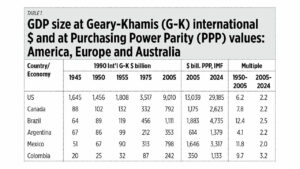Today is the 80th anniversary of the end of the Second World War (WW2). Sept. 2, 1945 saw the signing of the official surrender of Japan to the Allies, Germany had surrendered in May that year. So, it has been 80 years of no world war, only civil wars or war between neighbors, but not a continent-wide or world war. Congratulations humanity for prioritizing development and prosperity over war mongering.
How much has humanity prospered since the end of WW2? I checked the only available database that I know of, the Maddison Project by Prof. Angus Maddison and younger faculty of the University of Groningen in Netherlands. The database covers GDP size at 1990 values of Geary-Khamis (G-K) international $, population, GDP per capita, etc. by country from the First Century.
The GDP size of the Axis Powers in 1939 when WW2 started, in 1945 when the war ended, and post-war 1950 levels were as follows: Germany — $374.6 billion, $302.5 billion, $265.4 billion; Italy — $154.5 billion, $87.3 billion, $165 billion; and, Japan — $203.8 billion, $102.6 billion, $161 billion.
The Maddison database for GDP size is only until 2008 so I continued with the IMF database. Many countries, especially in Asia, do not have data for 1945 so to compute the multiples in GDP expansion, I used the data from 1950 to 2005. After five decades, Germany, Italy, France, the Netherlands, and the US have expanded only six times their original value while the UK expanded only four times. And from 2005-2024 or two decades, the same countries have expanded only two times (see Table 1).
In contrast, from 1950 to 2005, the Asian nations have expanded between 11 times (Philippines) to 63 times (Taiwan) except Bangladesh. And from 2005-2024, economies expanded between two times (Iran) to six times (China). Japan expanded 17 times after WW2 but expanded only 1.6 times in the last two decades (see Table 2).
We often hear the statement that “Post-WW2 the Philippines was second largest or richest economy in Asia next to Japan.” This is not true. In 1950, the Philippines was 8th largest, even smaller than the economies of Pakistan and Bangladesh.
The slow expansion in GDP size of Europe and America is also reflected in the slow expansion, even degrowth, in their total energy supply — from transportation to power generation. From 1965 (the earliest data available from the Energy Institute database) when Germany had 10.58 exajoules (EJ), this expanded in the 1970s and ’80s, then shrank to only 10.14 EJ in 2024. The UK fared even worse, from 8.32 EJ in 1965 to only 6.43 EJ in 2024.
In contrast, the energy supply over the same period has expanded 38 to 50 times from their base in 1965 in Indonesia, Malaysia, Vietnam, Thailand, and South Korea, 30 times in China, 12 times in the Philippines, and only three times in Japan (see Table 3).
East Asia has prospered a lot since WW2. But Japan has aligned its economic, energy, and climate policies with the US and Europe, and its expansion has significantly declined. The Philippines has the smallest energy supply among the countries listed — we are still in energy poverty compared to many of our East Asia neighbors.
The country’s current economic team, energy and environment sectors should abandon the West and the UN’s fear-mongering climate agenda. We should instead focus on more growth and prosperity, a bigger energy supply and be agnostic about where the supply comes from.
We should also ignore war mongering by certain sectors. We have had 80 years of no global war, we can have another 80 years or more of no world wars, and 80 years or more of continued economic prosperity instead.
Bienvenido S. Oplas, Jr. is the president of Bienvenido S. Oplas, Jr. Research Consultancy Services, and Minimal Government Thinkers. He is an international fellow of the Tholos Foundation.
minimalgovernment@gmail.com

